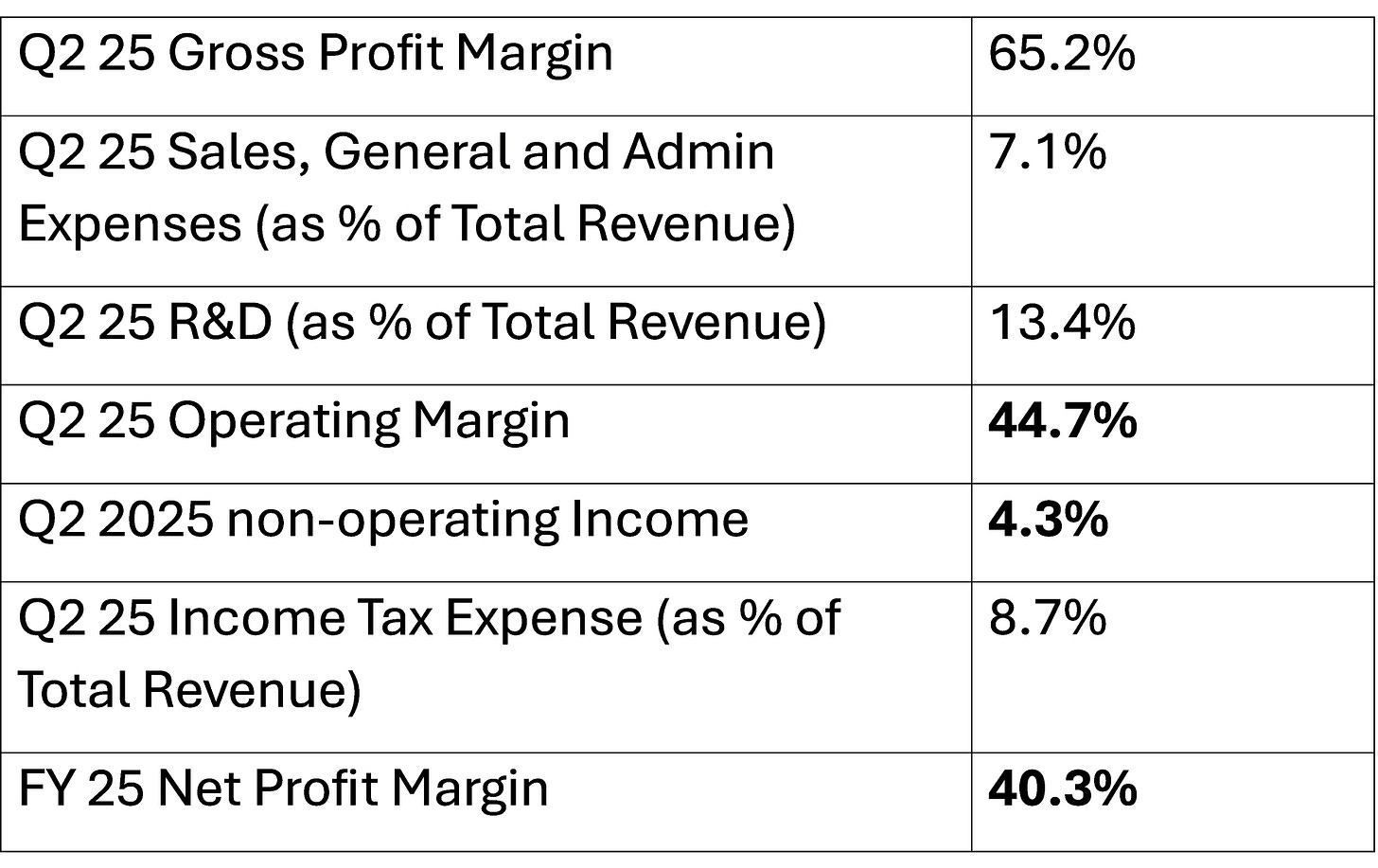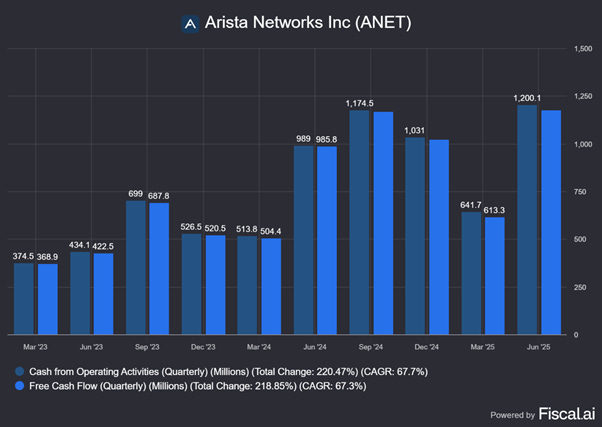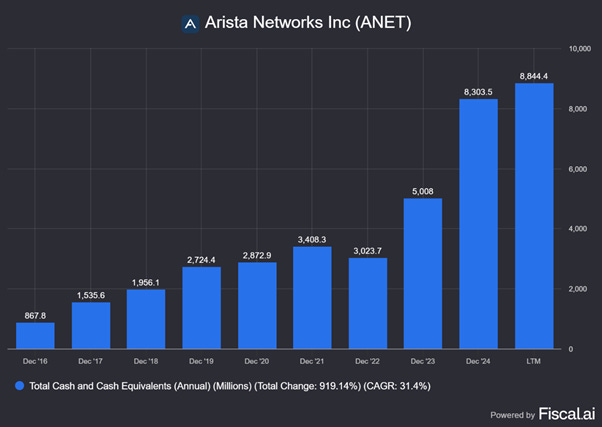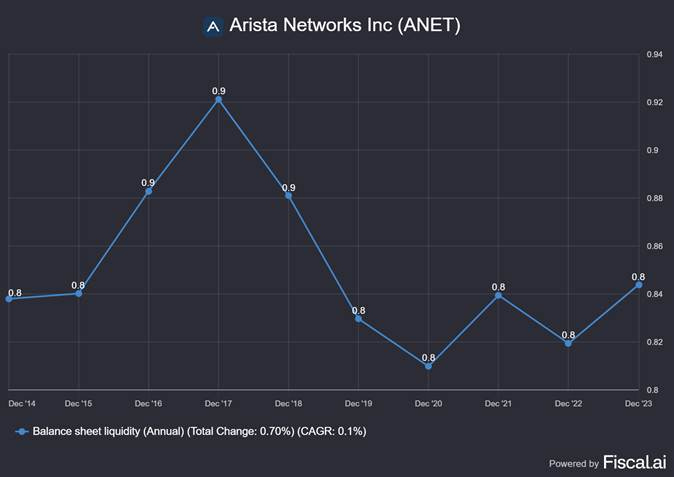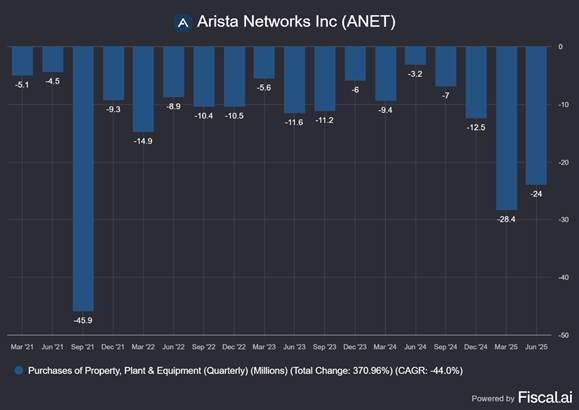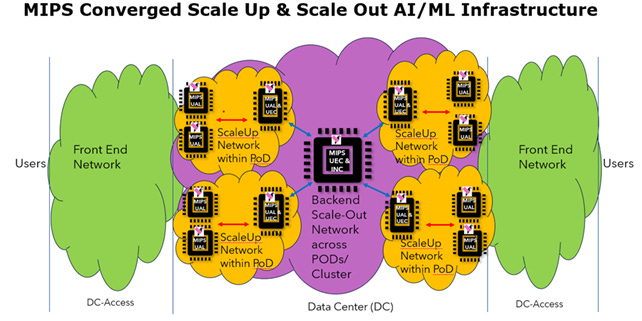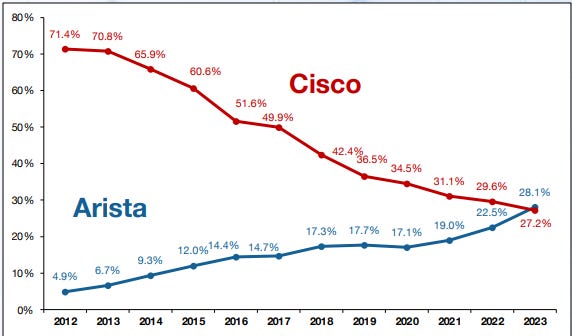Arista Networks (ANET)
Q2 2025 Results
We first covered the ANET stock in September 2023 and established a position soon afterwards. The original note can be found here. It is worth reading to get a good technical overview of the company. We have written a number of notes on the company since then. Some of these can be found here, here and here.
The most recent note can be found here. We revisit the company in the light of the Q2 2025 Results.
We always look forward to the ANET results as it has been one of our best investments along with MSFT, NVDA and BRK.B
Q2 2025 Results
Yahoo Finance Reported the numbers as follows:
“ANET reported strong second-quarter 2025 results, with revenues and adjusted earnings soaring year over year, driven by robust demand trends. Innovative product launches and steady customer additions backed by the company’s best-in-class portfolio strength led to top-line expansion, while steady margin improvement contributed to earnings growth. Both the bottom and the top lines beat the respective Zacks Consensus Estimate.”
The results beat management guidance, and ANET significantly raised the FY 2025 revenue outlook.
Total revenues in Q2 were $2.2 billion, up 30.4% (y/y) , above guidance of $2.1 billion.
Operating expenses for the quarter were $370.6 million, only up 13% (y/y).
Operating Profit rose 41% (y/y). This suggest the business continues to have strong operating leverage.
The 2025 guidance now sees 25% revenue growth, to $8.75bn billion, up from 17%. This is a significant change in six months suggesting the company is seeing noticeably higher demand.
International revenues for the quarter came in at $481 million or 21.8% of total revenue, up from 20.3% in the prior quarter. EMEA region was particularly strong.
Margins grew on a y/y basis. With very strong revenue growth and slightly higher, margins, this was another strong quarter for ANET.
A detailed analysis of the margins is shown below:
Arista sells specialist hardware manufactured by third parties. They also sell services and software they have developed themselves.
Gross margin is high at 65.2% but lower then pure software companies.
R&D spending at 13.4% of revenue is a major expanse. This increased in the quarter reflecting new product introduction costs in the period.
Sales, general and admin (SGA) costs at 7.1% are quite low indicating the efficiency of operations of the company.
Other income was 88.6 million and 4.3% of revenue. This primarily reflects interest earned on the $8bn worth of cash on the balance sheet.
These numbers are translating into higher cash flows.
Operating cash flow was $1.2bn (+ 21% (y/y)) and free cash flow was $1.17bn (+19.2% (y/y)).
The company has a strong balance sheet. It has no long- term debt and 8.8bn in Cash and short-term investments.
Balance sheet liquidity defined as current assets as percentage of total assets remains high at 85%.
As manufacturing is outsourced, the company has a very capital light model with the Capex to revenue ratio being less than 1%. Capital Expenditure is negligible.
Capital expenditures for the quarter was just $24mn in Q2. Capex is shown as a negative bar in the chart above as it is a cash outflow.
In the second quarter, they repurchased $196mn of common stock. Of the $1.5bn repurchase program approved in May 2025, $1.4bn remains available for repurchase in future quarters. These are small amounts given their net cash holdings of $ 8.8bn.
They had purchased more ( ~$820mn) in the previous quarter when the share price had fallen sharply in the market decline in April following the announcement of US tariffs on “Liberation Day”. This was a smart piece of capital allocation which has benefited those shareholders who did not sell as the share price has recovered sharply since then.
ANET has performed extremely well since its IPO.
The stock has given a CAGR total return of 39% (p.a.) over the last eleven years.
It has given a CAGR total return of 57.5% (p.a.) over the last five years.
A few years ago, ANET was riding high due to increased demand from the Cloud hyperscalers. Companies were increasingly moving their workloads away from high fixed-cost, on-premises infrastructure to the variable cost third-party Cloud.
The large cloud hyperscalers such as Amazon, Microsoft, Google, IBM, Oracle, Alibaba and others were investing billions of dollars in infrastructure.
While the bulk of this spending was on the physical infrastructure such as buildings, fittings, servers and silicon chips, there was also a need to increase spending on technology to wire up and interconnect the hardware to boost efficiency and performance.
Networking is important as the ANET management noted in the conference call.
Poor networks and bottlenecks lead to idle cycles on GPUs, wasting both capital GPU costs and operational expenses such as power and cooling. With a 30% to 50% processing time spent in exchanging data over networks and GPU, the economic impact of building an efficient GPU cluster with good networking improves utilization, and this is super paramount.
ANET has been the major beneficiary of this increased demand for more and better connectivity of datacentres and campuses.
Some investors worried about customer concentration as Microsoft and Meta accounted for 40% of ANET’s sales. However, these companies, along with other large tech companies have been large investors in datacentres and ANET has successfully ridden the wave.
In the last two years, investment has increased greatly since the advent the release of ChatGPT 3.5 in November 2022 and massive technological leaps in Generative AI.
The large tech companies are investing around $400bn per annum in AI datacentres and this is creating huge additional opportunities for companies like ANET.
We do expect aggregate AI networking revenue to be ahead of the $1.5bn in 2025 and growing in many years to come.
AI Datacentres : A technical digression
To understand the new opportunities created by AI for ANET, we need to look at some technical aspects which I, as a non-technical generalist, find difficult to comprehend.
The picture below is stylised illustration of a large AI datacentre network
For our current purposes we need to consider three layers of this.
1. Scale-Out Front-End networks
2. Scale-out Back-End networks
3. Scale-Up Back-End networks
Scale-Out Front-End networks
Scale-Out Front-End networks are the outer part of the network where the user connects with the network. Their primary role is to handle user or client requests—acting as the “external” access point.
They “receive” the incoming workload and requests and route to the available servers. If you add more servers, you increase the ability to handle more concurrent connections and users. Typically, scaling the front end is essential for managing spikes in user traffic and maintaining availability. The key aim is to reduce latency: i.e. the delay between a user action and the system’s response. The common networking protocols here are Ethernet and InfiniBand.
InfiniBand is specifically designed for high-performance applications with lower latency and higher bandwidth requirements than Ethernet. The network switches and bus adaptors for InfiniBand are manufactured by Mellanox which was acquired by Nvidia
Scale-Out Back End Networks
These networks interconnect the core computing components—for example, GPUs, storage nodes, or databases in the “back end”. It is responsible for heavy data crunching and internal system communication, rather than handling external user requests.
These internal interconnects are often made by NVLink or NV Switch.
NVLink is a high-speed, low-latency, and energy-efficient interconnect technology developed by Nvidia for connecting GPUs and other high-performance computing components.
The back-end network requires much higher bandwidth and much lower latency than front-end networks. For example, NVLink can operate at up to 10× the bandwidth of front-end Ethernet/InfiniBand connections.
Arista Networks is one of the key steering members (along with Broadcom, AMD, Meta, Microsoft and others) of the Ultra Ethernet Consortium (UEC). The UEC’s goal is to deliver a complete architecture that optimizes Ethernet for high performance AI and HPC networking, exceeding the performance of specialized technologies such as InfiniBand
On June 11, 2025, the UEC reached a significant milestone with the official release of UEC Specification 1.0 which is a comprehensive, Ethernet-based communication stack specifically designed for AI and HPC workloads.
Arista believe the front-end networks are starting to switch to Ethernet and away from InfiniBand. This is to the detriment of Nvidia’s networking business and to the benefit of companies like Arista and Cisco. If this is true, it will be a source of additional demand for Arista.
Historically, Arista has not been present in back-end network connectivity.
Scale-up back-end networks consist of high-bandwidth, low-latency interconnects that tightly link multiple accelerators within a single rack as a unified compute system with workload parallelism. Today, this is predominantly constructed with NVLink (Nvidia product) as a compute attached I/O, but we do expect a move to open standards such as Ethernet or UALink in the next few years.
However, with the new UEC standard, the world is expected the shift rapidly to Ethernet-based protocol rapidly in both the front end and the back end. This will happen to some extent blur the distinction between the two. ANET was targeting annual revenues of $750mn from back-end networking annually. The target has now been doubled.
Our stated goal of $750mn back-end AI networking is well on track and gaining from nearly 0 revenue 3 years ago in 2022 to production deployments this year in 2025. We were still able to, we believe, achieve $750 million in back-end targets revenue and exceed $1.5 billion for the year. As a reminder to you all, the back-end AI is all incremental revenue and incremental market share to Arista. As large language models continue to expand into distributed training and inference use cases, we expect to see the back-end and the front-end converge
Scale-up Networks
The third segment of the network is the Scale-up network. This is a new requirement arising due to ever more “tightly packed” datacentres. This will be a source of additional demand for ANET.
Scale-up is a new and unique requirement, and it particularly is going to come in as people start building more and more AI racks. when you're building an AI rack and you want to boost the ratings and performance of an individual rack or cluster and your XPU ratings gets bigger and bigger, you often need a very simple interconnect,
And so scale-up networks will be an incremental new market as Arista pursues it. Today, majority of that market lies inside a compute network structure and isn't something Arista is participating in.
We are very encouraged by the standards for Scale-Up Ethernet that Broadcom has initiated and we're big fans of. We think that Ethernet as a transport protocol is going to favor Arista and Broadcom very much.
Arista is likely to be the primary beneficiary and driver of the transition to open Ethernet protocols from Nvidia's proprietary InfiniBand / NVLink technology in GenAI networking.
ANET has the leading Ethernet products. Its flagship Etherlink and EOS are established hallmarks of scale-out networking and enjoy a wide breadth and depth of network protocol support.
The Etherlink portfolio is now 20-plus products with the most comprehensive and complete solution in the industry.
EOS is the Extensible Operating System which was covered in our first report on ANET. EOS is at the core of Arista cloud networking solutions for next-generation datacentres and cloud networks.
What is crystal clear to us and our customers is that Arista continues to be the premier and preferred AI networking platform of choice for all flavours of AI accelerators.
Customer concentration and customer Diversification
As noted above there was some concern about ANET’s customer concentration. Microsoft and Meta accounted for 40% of revenues. In the last conference call they mentioned they were having trials with three other large customers, which they dubbed Titans. In this call, they noted the the fifth Titan, which had been a sovereign AI, had dropped out of the running. They expect the remaining 4 Titans to be active
Two of our customers have already approached or going to quickly approach 100,000 GPUs. The third one might reach that goal. The fourth one that I said we just begin with is probably too early to reach that 100,000. That's probably a goal for next year. So that's the composition. Two are strong, one is medium.
However, beyond the titans they are seeing greater interest from other customers including the enterprise sector and Neoclouds.
As we continue to progress with our four top AI Titan customers, AI is also spreading its wings into the enterprise and Neocloud[1] sectors, and we are winning approximately 25 to 30 customers to date.
Don't underestimate the power of all these customers coming together as an aggregate adding to a very high number. So it's not your one Titan. As a collection, they're a Titan, but each one of them by themselves are a meaningful contributor.
As you look at the Campus, this is going to be very strategic, very large and very important because it's a large TAM of $25bn to $30bn.
Acquisition of VeloCloud
ANET has acquired a company called VeloCloud from Broadcom. This specialises in cloud-delivered SD-WAN (Software-Defined Wide Area Networking) solutions. Their customer base is composed of smaller enterprises rather than the large tech companies that ANET has focused on.
VeloCloud is small and their numbers will not be reflected in ANET’s numbers in 2025. However, it will help ANET increases business with enterprises from 2026 onwards.
They believe adding the VeloCloud customer base will be complementary to them.
it's incredibly complementary on two fronts. One is it fills an enormous hole in the enterprise campus portfolio for the distributed branch. And being able to bring Velo technology through our traditional Arista channel gives us an opportunity to cross- sell SD-WAN into so many existing campus accounts with the existing Arista go-to-market, which is amazing. But VeloCloud has a really strong MSP [2] motion.
We're pushing really hard right now in really embracing that not just to continue the Velo's success, but to now bring all of Arista's portfolio through that same channel through those same partners and really embrace that MSP motion and use the VeloCloud intellectual property in their business operation in order to learn from that and bring that MSP motion to all of Arista's portfolio.
The rapid rise in Agentic AI (Chatbots and the like) is increasing the volume data flowing through company networks : both Wide Area Networks (WAN) and Local area Networks (LAN)>
The rise in Agentic AI ensures any-to-any conversations with bidirectional bandwidth utilization. Such AI agents are pushing the envelope of LAN and WAN traffic patterns in the enterprise.
VeloCloud's secure AI optimized WAN portfolio offers seamless application-aware solutions to connect customer branch sites, complementing Arista's leading spines in the data center and campus.
This also increases our foothold with managed service providers, MSPs, as an important route to market for our distributed campus and branch offerings. We also intend to work closely with best-of-breed security partners to enable SASE[3] overlays.
We are now increasing our campus revenue target to be between $750 million and $800 million, inclusive of the minimal amount expected from the VeloCloud acquisition in FY '25.
Threat of cheap “White-Box” OEMs
Management was asked whether high and rising margins would lead to a loss of market share who made cheaper generic products called “White Boxes”.
In a combative reply, the company CEO argued the high margins reflected not just the value of their products but the efficiency of their operations.
49% operating margin is not a function of just our value, it's a function of our efficiency.
This company knows how to do more with less. We don't just throw thousands of marketing people, salespeople or engineers on one problem. And our customers appreciate that we don't have layers and hierarchies and big company corporate stuff, and we do this efficiently.
If somebody wants to buy the cheaper product, they are always free to do so. However, it may not work out cheaper in the long run as they may be reducing capital expenditure, but increasing operating expenditure.
You can trade CapEx for OpEx and vice versa. You can buy a cheap box and then you can support it yourself and you're going to need hundreds of engineers to do that. That's one model. And the other is Arista, where we'll put in the buffers, the congestion control, the value, the EOS and hopefully, you will need less support staff to do that.
Summary
ANET has become a leader in networking and has overtaken the one all -conquering Cisco in market share
It has ridden the boom in investment in cloud infrastructure by the large cloud hyperscalers such as Microsoft and companies such as Meta Platforms.
They are now benefitting from the huge unprecedented surge in investment in AI datacentres.
This is bringing new opportunities such as scale-up back-end networks where it has not been involved before. They predict back-end revenues this year will be $1.5b while some analysts are forecasting as high as $2bn.
The company will also benefit from the gradual switch from closed protocol such as InfiniBand and NVlink to open ones such as those based on Ethernet.
The company has performed very well, has strong operational efficiency metrics and a strong balance sheet.
The historical returns have been much greater than the likely cost of capital.
It could be argued the company is too conservatively managed and it could issue debt, leverage the balance sheet and increase shareholder returns to some extent.
Arista can be viewed like Nvidia as a “picks and shovels” play on the AI datacentres boom. However, it does not have Nvidia’s 90% dominant market share. GPUs have a much share of the investment wallet than networking hardware, software and services.
The Q2 results exhibited continued strength and the increase in FY 25 revenue forecast was impressive. This is a strong indication that the company will continue to perform well.
Valuation and Conclusion
At the current share price of $139 per share, the stock is trading at a two-year forward P/E ratio of 43X. The three- year forward PE is 35.6X. This is a little expensive for a company with an ROE of 33% and likely near-term EPS growth of at least 20%.
Our conservative estimate of the fair value of the share is in the range $95 to $105. However, our experience with this and other growth shares in the last three or four years is that the price runs ahead of the valuation estimates but the latter catch up. After the results, many analysts increased their fair value estimate of ANET stock from the $85-$ 95 range to the $105 -$120 range.
We currently have 3.7% of our portfolio invested in ANET. We will continue to hold as we expect it to continue to perform strongly and beat expectations.
[1]Neocloud” refers to a cloud provider that primarily offers GPU-as-a-Service (GPUaaS). The recently listed Coreweave is an example of a Neocloud company
[2] MSP is managed service provider
[3] SASE, or Secure Access Service Edge, is a cloud-based network architecture that converges networking and security functionalities into a unified, global platform





